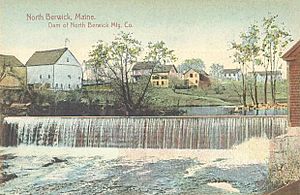Great Works River facts for kids
The Great Works River is a 30.6-mile-long (49.2 km) river in southwestern Maine, United States. It flows for about 30.6 miles (49.2 km) through York County. The river starts in central York County and flows south. It passes by the town of North Berwick. Finally, it joins the Salmon Falls River near South Berwick.
Contents
What is the Great Works River?
The Great Works River is an important waterway in Maine. It is known for its history and natural beauty. The river's journey begins in the middle of York County. From there, it makes its way south. It flows through different landscapes before reaching its end.
Where Does the River Flow?
The river flows past several towns. One major town it goes through is North Berwick. The river then continues its path. It eventually meets the Salmon Falls River. This meeting point is near the town of South Berwick. The part where it joins the Salmon Falls River is affected by ocean tides.
The River's Original Name and Early History
Long ago, the native people of the area lived near this river. They were the Newichawannock band of the Abenaki tribe. They had their own name for the river. They called it the Asbenbedick. This name reflects their deep connection to the land.
How the River Got Its Current Name
The name "Great Works River" comes from its industrial past. In July 1634, three men arrived from England. Their names were William Chadbourne, James Wall, and John Goddard. They came on a ship called the Pied Cow. Their mission was to build important mills.
Building the First Mills
These men were sent to build a sawmill and a gristmill. A sawmill cuts wood into lumber. A gristmill grinds grain into flour. These mills were built at a place called Assabumbadoc Falls. This spot was in a rocky area. It was below where Brattle Street bridge is today.
The sawmill they built was very special. It is thought to be the first water-powered mill in America. It used an "over-shot" water wheel. This means the water flowed over the top of the wheel to make it turn.
The "Great Mill Workes"
In 1651, the sawmill was rebuilt. A man named Richard Leader was in charge. He was an engineer. He was given special rights to use the river's water power. The new mill was much bigger. It had up to 20 saws. People started calling this large mill the "Great mill workes." This is where the Great Works River got its modern name. It shows how important these mills were to the area.


